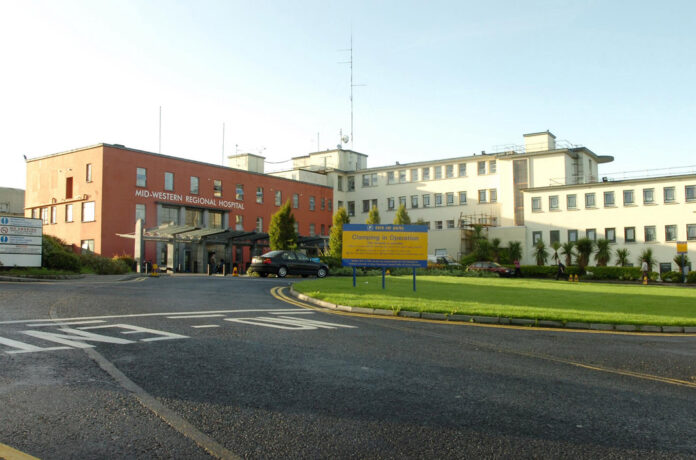THE failure of the Health Service Executive (HSE) to even mention the provision of a new 96-bed block at University Hospital Limerick in its capital projects plans for 2018 has been described as “mind-boggling” by a Clare TD.
Commenting on the publication of the HSE 2018 Service Plan, Deputy Timmy Dooley has expressed his disappointment with the fact there is no reference to the long-awaited new project at UHL under its capital infrastructure section.
The only reference to capital projects for UHL concerns the redevelopment of the old emergency department (ED), which the plan states will be completed next year and will be fully operational by the first quarter of 2019.
A UL Hospitals’ Group spokesman stated the development of the 96-bed block at UHL has been approved in principle by the HSE, subject to the normal conditions for such public works and subject to future capital funding availability.
The spokesman outlined that the first stage of the process is the appointment of a design team for the project.
“The procurement process for this is underway and is due to be completed in early 2018. The project will then need to be progressed through the design process. The first step in this regard will be outline design, then the planning process and finally the detailed design process. The project would then be ready to go to tender. It is estimated that the design phase could be completed by mid-2019.”
The award of a public works contract for the block would then be subject to capital funding availability for the cost of the construction works. It is estimated that the tender and evaluation stages for the works could be completed within three months.
“Once started on-site, construction could be completed within a further 18 months. The overall cost of the project is anticipated to be in the region of €25 million.
“There are currently very significant budgetary constraints over the next few years, primarily due to current capital commitments in respect of major government priority projects. The delivery of the project in such a timeframe would, therefore, be contingent on an increase in the current projected capital allocation for health in future years,” the spokesperson added.
Many patients are still waiting for long periods on trolleys in the ED at UHL, due to the lack of long-stay beds.
According to the INMO’s Trolley Watch, there were 36 patients on trolleys at UHL on December 21. This figure fell to 22 on December 22 and remained at this level on Wednesday, December 27.
The level of overcrowding has prompted stinging criticism of the HSE from Deputy Dooley, following the publication of its 2018 Service Plan.
“It is mind-boggling that there has been no mention for the 96-bed ward block, when it has been recognised at ministerial level and across the political divide that this is an absolute imperative in order to improve throughput at the new ED.
“Not doing this, and by creating spaces in areas apart from wards, is only tinkering around the edges. We needs wards for patients to be treated once they are admitted. Creating greater holding bays is not the answer. We need to progress medium and long-term plans for the hospital, which is not the case in this plan,” he said.
In addition to substantially increasing the number of beds at UHL, Deputy Dooley proposed that upgrading and increasing the theatre capacity in Ennis Hospital would facilitate the completion of more day work in Ennis, which in turn would reduce the pressure on UHL.
He said implementing these two measures would have a meaningful impact on massive overcrowding in UHL, which is by far the worst in the country and is providing a “poor service for people in the Mid-West”.
The service plan includes a goal to “provide fair, equitable and timely access to quality, safe health services that people need”.
It aims to improve the provision of unscheduled care; improve pathways for care of older people living with frailty in acute hospitals; in association with the Integrated Care Programme for Older Persons and “ensure that no patient remains over 24 hours in ED”.
The plan seeks to improve efficiencies relating to in-patient and day case activity by streamlining processes and by maximising capacity in acute hospitals. It commits to open additional beds and new units to increase capacity and improve access over the winter period in a number of acute hospitals, including UHL and University Hospital Galway.
Asked about the apparent contradictions in the HSE plan and the reality for Clare and Mid-West patients, Deputy Dooley stated, “There is a very significant contradiction in the HSE Service Plan because, if this plan aims to improve the patient experience in ED in UHL, then that can’t happen by just writing it down on a document.
“There is significant investment required to achieve this. The construction of the 96-bed ward block is an essential component for ensuring a faster throughput for patients through the ED,” he said.
The plan outlined that the €1.32m first phase of the redevelopment of Ennis Hospital is due to be completed by the end of 2017 and should be fully operational by the end of the first quarter in 2018.
This consists of the fit-out of vacated areas in the existing building to accommodate physiotherapy and pharmacy and the reconfiguration of layouts and the provision of a viewing room.
By Dan Danaher
A native of Ennis, Colin McGann has been editor of The Clare Champion since August 2020. Former editor of The Clare People, he is a journalism and communications graduate of Dublin Institute of Technology.


